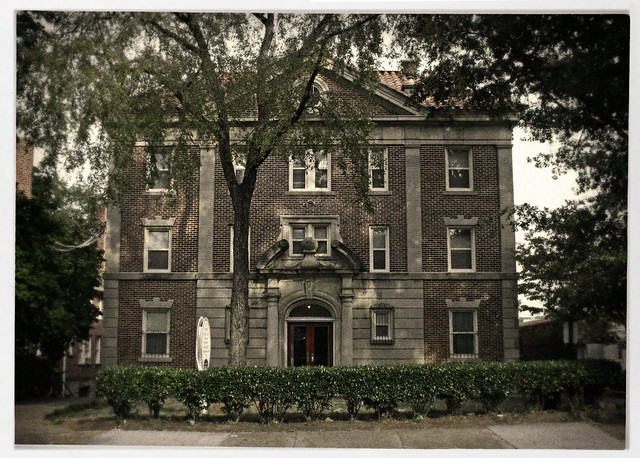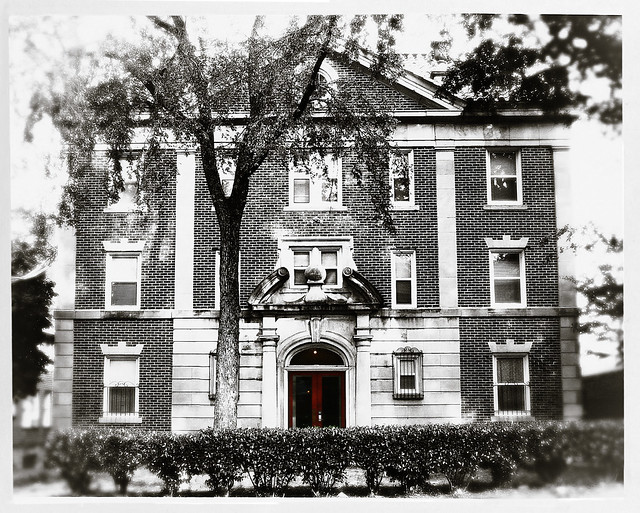
Enlargement
I placed this image on Wikipedia in the public domain
Surprise, surprise, to realize this apartment building, out of all of them around here, is on the National Register of Historic Places, due the fact that of all the apartment buildings around here I’ve always thought of it as being one of lesser distinction, and has had, frankly, some problems. At least it used to have some problems. Like the time there was the yellow ribbon all over out front because of the guy who lived there who was shot and managed to make his way out on the street before dying. Some drug thing, at least that’s what I heard from others who’d heard, but then one never gets the full story, so for all I know what I’ve related here could be wrong. But that was four years ago and four years ago is a long while. I probably wrote about it on this very blog because Aaron was kind of taken aback by the yellow tape as we passed by it the next day and that yellow tape to a ten year old is a big deal.
“Is that where the man was murdered?!”
“Uhm, yeah, honey.”
Today a guy was out walking his little dog and there were no pools of blood lying about. All was peaceable and good.
Looking up rentals there, if one is on the south side in the second floor one gets a nice view of the downtown Atlanta skyline. And, admittedly, taking an opportunity to contemplate it, the architectural details on the facade are nice. Its reference number is 91001853 on the NRHP, designed by architect Russell Conklin in 1924. Built of concrete, brick and terra cotta, its architectural style is Italian Renaissance Revival.
The 1930 census (spread out piecemeal over several pages) shows at 705 Piedmont:
Edward Lanham and wife Eva, he a salesman and she an hotel secretary;
Howard Lauduback and wife Mabel, Howard an auto tires manager;
Allen Rutledge and boarder Roselle Barron, both working as assistants in a doctor’s office;
Mary Anderson, a saleswoman in a department store;
Robert Rankin and wife Susie, he a rates clerk at the freight bureau, and she a stenographer at a lumber company;
Wilber B. Savage and wife Laurence, and father-in-law Solomon Kline, Wilber a lawyer with an insurance company;
Marion White, an African-American janitor;
Arnalde Woodyard and wife Edith, he an instructor at a college, and both from Ohio;
William Badon and wife Anne, William working at the railroad;
Josephine Mailey, from Ohio, a technician at a doctor’s office;
Clyde Kirkle and wife Lenora, he a dentist in general practice.
Rents were typically 47.50, except for Marion, who paid $20.
In the 1940 census, at 705 Piedmont, the families listed are:
Will Cobb and wife Amy;
G. R. Terence, public school teacher;
L. M. Connell from Florida;
Willie Mae Ivey and her sister and niece, the latter two being bookkeepers;
James Thomas and wife, he a foreman;
Charles E. Hall and wife, he a police officer at the National Bank;
Ross C. Chambers and his divorced mother, Ross being a retail clerk and his mother a saleslady;
M. S. Spurgin and his wife, from Iowa, he an auto insurance adjuster and Adelaide a saleswoman;
Leonore Rainer, a divorcee who was living in China in 1935;
D. E. Swainsrom, an auto parts salesman, and his wife, Helen, an Insurance office clerk;
Mrs. J. F. DeJarnett, a specialist at the U.S. Trust, and lodger Mary L. Taylor, an RN on private duty;
Alma Newbury, another RN on private duty;
Ruth Roberts, a divorced secretary with the farm loan;
Pauline B. Cox, an RN on private duty;
Henry Smith and wife and 18 year old daughter (the sole African-American family), he an apartment house janitor, his wife and daughter maids in private homes;
Mae Carrington and Dorothy, one a secretary and the other a stenographer;
Virgnia Eastling, a stenographer;
Duke Farson and his wife, Gladys, and son, Richard, the father being a salesman;
Charles G. Holder and his brother John, one an office manager with the state highway and the other a staff accountant with the telephone company;
Elizabeth Allen, divorced, and daughter Catherine, one a ready-to-wear manager and the other a bookkeeper;
D. Y. Yancy and wife Ruby, one a salesman and the other…can’t quite make it out;
Mildred Clerk, who worked as a medical librarian;
Christine Coleman, who worked as a sales clerk in a grocery store.
That’s an increase from 11 to 23 households between 1930 and 1940. Had this to do with lingering effects of the depression? I don’t know. Where did they put them all?
Marion White, in 1930, and Henry Smith and his family, in 1940, as African-Americans, would have been present in the building because they were custodians of the property.


Leave a Reply